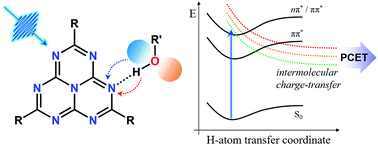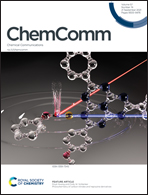Photochemistry of carbon nitrides and heptazine derivatives
Abstract
We explore the photochemistry of polymeric carbon nitride (C3N4), an archetypal organic photocatalyst, and derivatives of its structural monomer unit, heptazine (Hz). Through spectroscopic studies and computational analysis, we have observed that Hz derivatives can engage in non-innocent hydrogen bonding interactions with hydroxylic species. The photochemistry of these complexes is influenced by intermolecular nπ*/ππ* mixing of non-bonding orbitals of each component and the relative energy of intermolecular charge-transfer (CT) states. Coupling of the former to the latter appears to facilitate proton-coupled electron transfer (PCET), resulting in biradical products. We have also observed that Hz derivatives exhibit an extremely rare inverted singlet/triplet energy splitting (ΔEST). In violation of Hund's multiplicity rules, the lowest energy singlet (S1) is stabilized relative to the lowest triplet (T1) electronic excited state. Exploiting this unique inverted ΔEST character has obvious implications for transformational discoveries in solid-state OLED lighting and photovoltaics. Harnessing this inverted ΔEST, paired with light-driven intermolecular PCET reactions, may enable molecular transformations relevant for applications ranging from solar energy storage to new classes of non-triplet photoredox catalysts for pharmaceutical development. To this end, we have explored the possibility of optically controlling the photochemistry of Hz derivatives using ultrafast pump–push–probe spectroscopy. In this case, the excited state branching ratios among locally excited states of the chromophore and the reactive intermolecular CT state can be manipulated with an appropriate secondary “push” excitation pulse. These results indicate that we can predictively redirect chemical reactivity with light in this system, which is an avidly sought achievement in the field of photochemistry. Looking forward, we anticipate future opportunities for controlling heptazine photochemistry, including manipulating PCET reactivity with a diverse array of substrates and optically delivering reducing equivalents with, for example, water as a partial source of electrons and protons. Furthermore, we wholly expect that, over the next decade, materials such as Hz derivatives, that exhibit inverted ΔEST character, will spawn a significant new research effort in the field of thin-film optoelectronics, where controlling recombination via triplet excitonic states can play a critical role in determining device performance.



 Please wait while we load your content...
Please wait while we load your content...